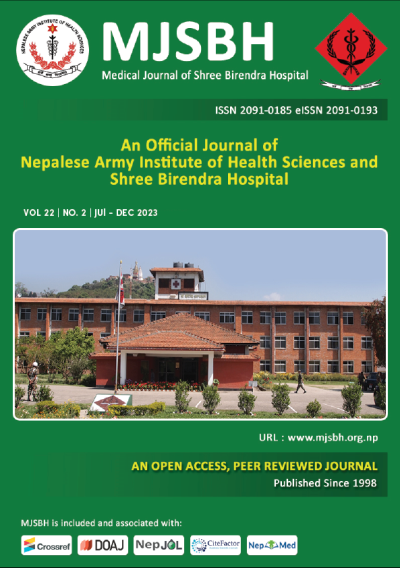Early versus Delayed Feeding in Uncomplicated Primary Caesarean Section - A Comparative Study at Shree Birendra Hospital
DOI:
https://doi.org/10.3126/mjsbh.v22i2.66353Keywords:
Cesarean section, Early feeding, Paralytical ileusAbstract
Introduction: Conventionally, oral feeding is delayed after Caesarean section fearing delayed bowel motility. This study is designed to compare early oral feeding within six hours versus our conventional delayed 24 hours of oral feeding for women at term undergoing primary Caeserean section.
Methods: A prospective, comparative study was conducted over a six months period at Shree Birendra Hospital, Kathmandu, Nepal. All pregnant ladies undergoing uncomplicated Caeserean section at 37 to 42 weeks of gestation were randomly placed in two groups: (A) Early feeding group (Oral fluids within six hours) (54) and (B) Delayed feeding group (Oral fluids after 24 hours) (56). The patients were noted for symptoms of nausea, vomiting, abdominal distension, return of bowel sound, passing of flatus, duration of stay in hospital and total IV fluid requirements.
Results: The passage of flatus was significantly earlier in Group A compared to Group B (12.54 hours vs 15.38 hours - p < 0.05). Appearance of bowel sounds was also earlier in Group A (8.85 hours vs 12.63 hours – p < 0.05). The mean IV fluid requirement was comparatively less in Group A (4.15 litres vs 5.71 litres – p < 0.05). The average hospital stay was also significantly less in Group A (2.89 days vs 4.16 days - p < 0.05).
Conclusion: Early feeding in patients undergoing uncomplicated primary Caesarean section is safe, generally well tolerated with early return to bowel functions, less intravenous fluid requirements and reduced duration of hospital stay.
Downloads
Downloads
Published
How to Cite
Issue
Section
License
Copyright (c) 2024 Medical Journal of Shree Birendra Hospital

This work is licensed under a Creative Commons Attribution-NonCommercial 4.0 International License.
This license enables reusers to distribute, remix, adapt, and build upon the material in any medium or format for noncommercial purposes only, and only so long as attribution is given to the creator.




